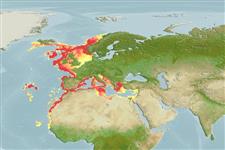Common names from other countries
Environment: milieu / climate zone / depth range / distribution range
Ecologia
; intervalo de profundidade 32 - 899 m (Ref. 1695), usually 200 - 400 m (Ref. 1695). Temperate; 70°N - 13°N, 33°W - 36°E (Ref. 1695)
Eastern Atlantic and the Mediterranean: From East Greenland and Iceland to the Mediterranean and northwest Africa. Temperate to polar.
Length at first maturity / Tamanho / Peso / Idade
Maturity: Lm ? range ? - ? cm Max length : 10.0 cm ML macho/indeterminado; (Ref. 122093)
Common mantle length: 2.0 to 6.0 cm (Ref. 1695, p. 184). Common mantle length ranges between 2 and 6 cm (Ref. 3722). Hyperbenthic (Ref. 106087). Found over sandy-muddy areas offshore from 32 to 899 m depth. In the western Mediterranean, observed to prefer deeper waters in winter and in shallower coastal waters during spawning and throughout the rest of the year. Polytelic. Spawning takes place throughout the year, peaking in spring and autumn. Mating behavior involves the male grasping the female's 'neck' region followed by the insertion of its hectocotylus into the female's mantle cavity. Eggs are laid in small clusters of 30 to 40, covered with a hard, violet-red coat; commonly found on bivalve shells of Pinna sp. Or on other solid substrates. Eggs hatch after 45 days in water temperature of about 16°C. Females mature at 8 to 11 months and are larger than males that mature at 7 to 8 months. Longevity is approximately 12 months. Of minor commercial importance, mostly as bycatch in bottom trawls, although generally never abundant. Among countries in the Mediterranean, it is variedly valued for its tasty meat and sold fresh or frozen in fish markets (Ref. 1695).
Life cycle and mating behavior
Maturidade | Reprodução | Desova | Ovos | Fecundidade | Larvas
Members of the class Cephalopoda are gonochoric. Male and female adults usually die shortly after spawning and brooding, respectively. Mating behavior: Males perform various displays to attract potential females for copulation. During copulation, male grasp the female and inserts the hectocotylus into the female's mantle cavity where fertilization usually occurs. Life cycle: Embryos hatch into planktonic stage and live for some time before they grow larger and take up a benthic existence as adults.
Jereb, P. and C.F.E. Roper (eds.). 2005. (Ref. 1695)
Categoria na Lista Vermelha da IUCN (Ref. 130435)
Categoria CITES (Ref. 108899)
Not Evaluated
Not Evaluated
Utilização humana
Pescarias: pouco comercial
| FishSource |
Ferramentas
Fontes da internet
Estimates based on models
Preferred temperature
(Ref.
115969): 6.1 - 14.4, mean 9.5 (based on 266 cells).
Vulnerabilidade
Low vulnerability (10 of 100).
Categoria de preço
Unknown.
